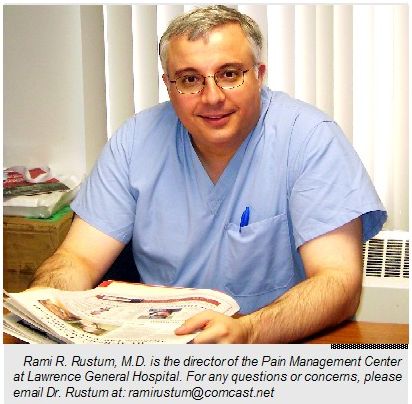The Doctor is 
Managing pain with medications
... Part I
Dr,
Rami Rustum
 “My
doctor sent me here to get my pain
medications”. “My
doctor sent me here to get my pain
medications”.
This might sound a routine statement to
many pain physicians. I can say that at
least once a week I hear it from one
patient referred to our pain clinic!
There is no doubt that prescribing pain
killers proposes a dilemma to many care-
givers, but what would be the reasons for
such problems?
I believe there is no easy or convincing
answer to this question despite the
wide-spread knowledge about the available
pain medications on the market since it
is multi-factorial problem! But one of
the answers is: the physician’s fear
of the patients’ drug abuse or
addiction and to a lesser degree the
opposite direction: patient’s fear
of becoming addicted!
The problem has been on the rise
nationally despite vigorous efforts to
crack down on the violators.
Narcotics abuse and/ or addiction are two
serious problems which could be difficult
to manage by already overwhelmed
physician dealing with other health
issues like Diabetes, Asthma, High blood
pressure, Stroke…etc.
On the other hand, can you imagine what
will happen if every patient is referred
to the pain clinic for the script?!
Simply put, we will have patients
standing in lines!!
In order to avoid such issues, some
clinics tell the patient that they only
do injections and don’t prescribe
medications!! This is also not
acceptable.
The success in preventing abuse/addiction
depends on the efforts of BOTH:
Patient + Physician (PP).
I always believed (and still do) that the
success part of the physician depends on
his belief that pain is a DISEASE like
asthma, diabetes or high blood pressure.
So the problem should be explored
carefully with specific attention paid to
all previous treatments, social and
medical history.
Let’s examine the PP relationship:
˛- The Patient: Usually constitutes the
passive part in the relationship …
meaning: the patient comes to receive the
appropriate treatment to reduce his pain.
However, this is not the case every time.
Many patients come to request certain
medication since EVERYTHING ELSE HAD
FAILED!
Someone can argue that there is some
truth in such a statement, but how do you
define failure?
Is it inadequate pain relief?
Is it having side effects?
How do we measure pain relief? Is it just
a number on a scale?
Is it improved function or is it being
less pills taken??
The patient must remember that the
goal is controlling the pain and
improving quality of life not the name of
the medication.
II- The Physician: bears the active
role in the relationship; however, this
doesn’t make it easier since every
physician should be his patient’s
advocate!
To a certain extent, the physician may
play some role in abuse/addiction
problem, but how?
1- Failure to adequately assess the
condition and rushing to prescribe
narcotics: remember, narcotics are NOT
the first line in treatment and other
options like physical therapy, injections
or over counter pain medications should
be tried.
2- Failure to offer alternative
treatment options to the narcotics: as
mentioned above.
3- Failure to monitor the patient by
doing random urine and/ or blood
toxicology screening, random pill count….etc.
4- Failure to recognize previous
“alarming signs” as previous
addiction problem, changing physicians
frequently, too many E.R. visits, asking
for specific medication, and/or calling
for early refills.
5- Failure to confront the patient
with the problem as it rises.
6- Failure to recognize a serious
problem in prescribing narcotics on
“as needed bases”.
7- Failure to recognize the
difference between addiction vs.
tolerance.
8- Failure to recognize when to
switch short acting narcotic to a longer
acting one: A patient with lower back
pain may require 1-2 tablets of Percocet
per day. If the condition worsens the
need for medications will increase and
the common mistake committed here is to
increase the Percocet tablets instead of
switching to longer acting drug like
Duragesic® or MS Contin supplemented
with FEWER Percocets!
The discussion may go on and on with a
two-way argument on both sides, but the
bottom line is to have the patient
engaged in the treatment plan as the
first step as much as possible and not to
be afraid of making appropriate and
necessary changes to the plan as the
problem progresses.
>>>>>>>>>>>>>>>>>>>>>>>>>>>>>>>>>>>>>>>>>>>>>>>>>>>>>>>>>>>>>>>>>>>>>>>>>>>>>>>>>>>
>>>>>>>>>>>>>>>>>>>>>>>>>>>>>>>>>>>>>>>>>>>>>>>>>>>>>>>>>>>>>>>>>>>>>>>>>>>>>>>>>>>>>>>>>>>
All
pictures and material are
(C) copyright, Valley Patriot, Inc., 2008
|